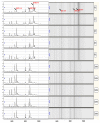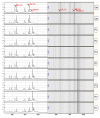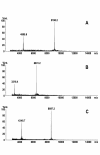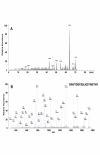Discovery and identification of potential biomarkers of papillary thyroid carcinoma
- PMID: 19785722
- PMCID: PMC2761863
- DOI: 10.1186/1476-4598-8-79
Discovery and identification of potential biomarkers of papillary thyroid carcinoma
Abstract
Background: Thyroid carcinoma is the most common endocrine malignancy and a common cancer among the malignancies of head and neck. Noninvasive and convenient biomarkers for diagnosis of papillary thyroid carcinoma (PTC) as early as possible remain an urgent need. The aim of this study was to discover and identify potential protein biomarkers for PTC specifically.
Methods: Two hundred and twenty four (224) serum samples with 108 PTC and 116 controls were randomly divided into a training set and a blind testing set. Serum proteomic profiles were analyzed using SELDI-TOF-MS. Candidate biomarkers were purified by HPLC, identified by LC-MS/MS and validated using ProteinChip immunoassays.
Results: A total of 3 peaks (m/z with 9190, 6631 and 8697 Da) were screened out by support vector machine (SVM) to construct the classification model with high discriminatory power in the training set. The sensitivity and specificity of the model were 95.15% and 93.97% respectively in the blind testing set. The candidate biomarker with m/z of 9190 Da was found to be up-regulated in PTC patients, and was identified as haptoglobin alpha-1 chain. Another two candidate biomarkers (6631, 8697 Da) were found down-regulated in PTC and identified as apolipoprotein C-I and apolipoprotein C-III, respectively. In addition, the level of haptoglobin alpha-1 chain (9190 Da) progressively increased with the clinical stage I, II, III and IV, and the expression of apolipoprotein C-I and apolipoprotein C-III (6631, 8697 Da) gradually decreased in higher stages.
Conclusion: We have identified a set of biomarkers that could discriminate PTC from non-cancer controls. An efficient strategy, including SELDI-TOF-MS analysis, HPLC purification, MALDI-TOF-MS trace and LC-MS/MS identification, has been proved successful.
Figures





Similar articles
-
Detection and identification of potential biomarkers of non-small cell lung cancer.Technol Cancer Res Treat. 2009 Dec;8(6):455-66. doi: 10.1177/153303460900800607. Technol Cancer Res Treat. 2009. PMID: 19925029
-
[Detection and identification of specific serum biomarkers in papillary thyroid cancer].Zhonghua Zhong Liu Za Zhi. 2009 Apr;31(4):265-8. Zhonghua Zhong Liu Za Zhi. 2009. PMID: 19615280 Chinese.
-
Detection and identification of potential biomarkers of breast cancer.J Cancer Res Clin Oncol. 2010 Aug;136(8):1243-54. doi: 10.1007/s00432-010-0775-1. Epub 2010 Mar 17. J Cancer Res Clin Oncol. 2010. PMID: 20237941 Free PMC article.
-
Detection and Identification of Serum Peptides Biomarker in Papillary Thyroid Cancer.Med Sci Monit. 2018 Mar 17;24:1581-1587. doi: 10.12659/msm.907768. Med Sci Monit. 2018. PMID: 29549708 Free PMC article.
-
VHL tumor suppressor as a novel potential candidate biomarker in papillary thyroid carcinoma.Biomol Biomed. 2023 Feb 1;23(1):26-36. doi: 10.17305/bjbms.2022.7850. Biomol Biomed. 2023. PMID: 36036061 Free PMC article. Review.
Cited by
-
Apolipoproteins as Differentiating and Predictive Markers for Assessing Clinical Outcomes in Patients with Small Cell Lung Cancer.Yonsei Med J. 2016 May;57(3):549-56. doi: 10.3349/ymj.2016.57.3.549. Yonsei Med J. 2016. PMID: 26996551 Free PMC article.
-
Papillary Thyroid Cancer: Genetic Alterations and Molecular Biomarker Investigations.Int J Med Sci. 2019 Feb 28;16(3):450-460. doi: 10.7150/ijms.29935. eCollection 2019. Int J Med Sci. 2019. PMID: 30911279 Free PMC article. Review.
-
Identifying potential breath biomarkers for early diagnosis of papillary thyroid cancer based on solid-phase microextraction gas chromatography-high resolution mass spectrometry with metabolomics.Metabolomics. 2024 May 21;20(3):59. doi: 10.1007/s11306-024-02119-w. Metabolomics. 2024. PMID: 38773019
-
Opportunities and challenges facing biomarker development for personalized head and neck cancer treatment.Head Neck. 2013 Feb;35(2):294-306. doi: 10.1002/hed.21975. Epub 2012 Jan 27. Head Neck. 2013. PMID: 22287320 Free PMC article. Review.
-
Circulating Proteins Associated with Response and Resistance to Neoadjuvant Chemotherapy in HER2-Positive Breast Cancer.Cancers (Basel). 2022 Feb 21;14(4):1087. doi: 10.3390/cancers14041087. Cancers (Basel). 2022. PMID: 35205837 Free PMC article.
References
-
- Pelizzo MR, Merante Boschin I, Toniato A, Casal Ide E, Mian C, Rubello D, Pagetta C. Diagnosis, treatment, prognostic factors and long-term outcome in papillary thyroid carcinoma. Minerva Endocrinol. 2008;33:359–379. - PubMed
-
- Hayashi N, Kitaoka M. Fine-needle aspiration biopsy of the thyroid nodule: uses and limitations. Nippon Rinsho. 2007;65:2003–2007. - PubMed
-
- Inohara H, Segawa T, Miyauchi A, Yoshii T, Nakahara S, Raz A, Maeda M, Miyoshi E, Kinoshita N, Yoshida H, Furukawa M, Takenaka Y, Takamura Y, Ito Y, Taniguchi N. Cytoplasmic and serum galectin-3 in diagnosis of thyroid malignancies. Biochem Biophys Res Commun. 2008;376:605–610. doi: 10.1016/j.bbrc.2008.09.041. - DOI - PubMed
Publication types
MeSH terms
Substances
LinkOut - more resources
Full Text Sources
Other Literature Sources
Medical
Miscellaneous

